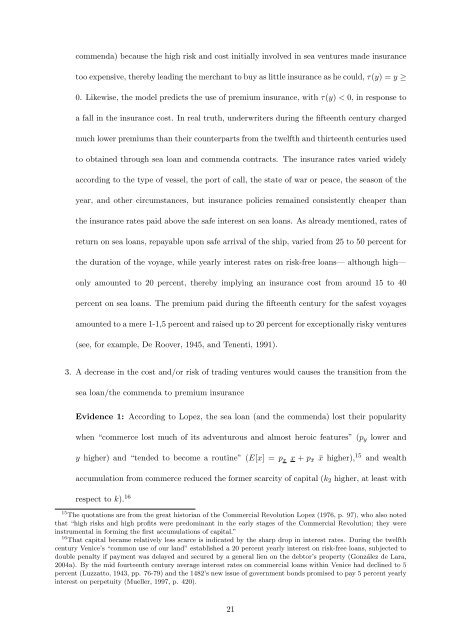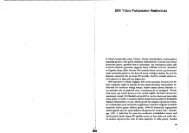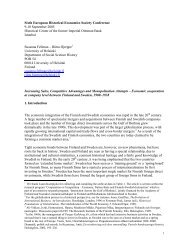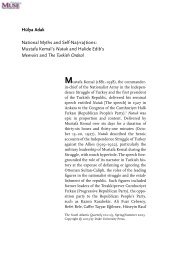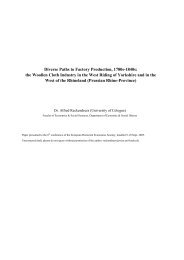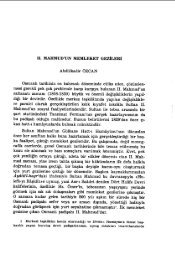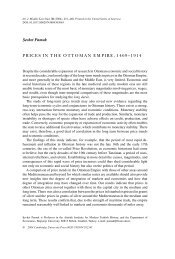The Birth of Insurance Contracts - The Ataturk Institute for Modern ...
The Birth of Insurance Contracts - The Ataturk Institute for Modern ...
The Birth of Insurance Contracts - The Ataturk Institute for Modern ...
Create successful ePaper yourself
Turn your PDF publications into a flip-book with our unique Google optimized e-Paper software.
commenda) because the high risk and cost initially involved in sea ventures made insurance<br />
too expensive, thereby leading the merchant to buy as little insurance as he could, τ(y) = y ≥<br />
0. Likewise, the model predicts the use <strong>of</strong> premium insurance, with τ(y) < 0, in response to<br />
a fall in the insurance cost. In real truth, underwriters during the fifteenth century charged<br />
much lower premiums than their counterparts from the twelfth and thirteenth centuries used<br />
to obtained through sea loan and commenda contracts. <strong>The</strong> insurance rates varied widely<br />
according to the type <strong>of</strong> vessel, the port <strong>of</strong> call, the state <strong>of</strong> war or peace, the season <strong>of</strong> the<br />
year, and other circumstances, but insurance policies remained consistently cheaper than<br />
the insurance rates paid above the safe interest on sea loans. As already mentioned, rates <strong>of</strong><br />
return on sea loans, repayable upon safe arrival <strong>of</strong> the ship, varied from 25 to 50 percent <strong>for</strong><br />
the duration <strong>of</strong> the voyage, while yearly interest rates on risk-free loans— although high—<br />
only amounted to 20 percent, thereby implying an insurance cost from around 15 to 40<br />
percent on sea loans. <strong>The</strong> premium paid during the fifteenth century <strong>for</strong> the safest voyages<br />
amounted to a mere 1-1,5 percent and raised up to 20 percent <strong>for</strong> exceptionally risky ventures<br />
(see, <strong>for</strong> example, De Roover, 1945, and Tenenti, 1991).<br />
3. A decrease in the cost and/or risk <strong>of</strong> trading ventures would causes the transition from the<br />
sea loan/the commenda to premium insurance<br />
Evidence 1: According to Lopez, the sea loan (and the commenda) lost their popularity<br />
when “commerce lost much <strong>of</strong> its adventurous and almost heroic features” (py lower and<br />
y higher) and “tended to become a routine” (E[x] = px x + p¯x ¯x higher), 15 and wealth<br />
accumulation from commerce reduced the <strong>for</strong>mer scarcity <strong>of</strong> capital (k2 higher, at least with<br />
respect to k). 16<br />
15 <strong>The</strong> quotations are from the great historian <strong>of</strong> the Commercial Revolution Lopez (1976, p. 97), who also noted<br />
that “high risks and high pr<strong>of</strong>its were predominant in the early stages <strong>of</strong> the Commercial Revolution; they were<br />
instrumental in <strong>for</strong>ming the first accumulations <strong>of</strong> capital.”<br />
16 That capital became relatively less scarce is indicated by the sharp drop in interest rates. During the twelfth<br />
century Venice’s “common use <strong>of</strong> our land” established a 20 percent yearly interest on risk-free loans, subjected to<br />
double penalty if payment was delayed and secured by a general lien on the debtor’s property (González de Lara,<br />
2004a). By the mid fourteenth century average interest rates on commercial loans within Venice had declined to 5<br />
percent (Luzzatto, 1943, pp. 76-79) and the 1482’s new issue <strong>of</strong> government bonds promised to pay 5 percent yearly<br />
interest on perpetuity (Mueller, 1997, p. 420).<br />
21


